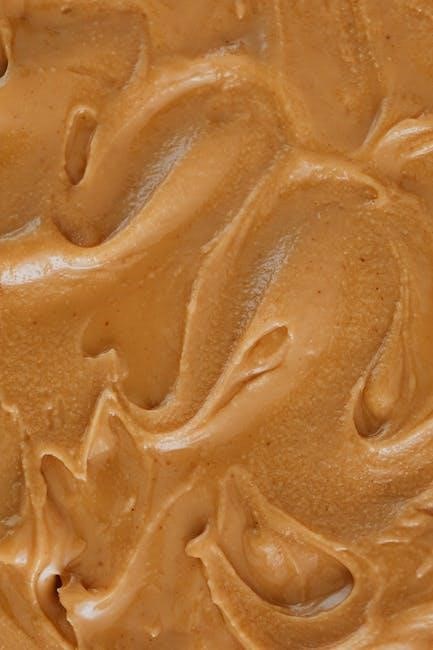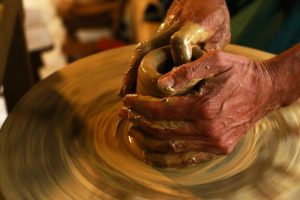
A manual butter churner is a simple, eco-friendly tool that allows you to make homemade butter with control over ingredients, texture, and fat content.
What is a Manual Butter Churner?
A manual butter churner is a hand-powered kitchen tool designed to transform heavy cream into homemade butter. It typically consists of a churn, a turning handle, and internal paddles that agitate the cream. This device allows users to control the churning process, ensuring customizable texture and flavor. It’s eco-friendly, cost-effective, and offers a fun, traditional way to make fresh butter without electricity, perfect for home use or small-scale production.
History of Butter Churners
The origins of butter churners date back to ancient times, with early civilizations using animal stomachs or wooden churns to separate butterfat from cream. By the Middle Ages, churns became a common kitchen tool, evolving into wooden or metal designs. In the 19th century, mechanical advancements introduced hand-crank models, simplifying the process. Traditionally, butter churners were a staple in rural households, symbolizing self-sufficiency. Today, manual churners experience a revival, cherished for their simplicity and connection to heritage.
Why Use a Manual Butter Churner?
Manual butter churners offer unparalleled control over butter’s texture, fat content, and flavor, allowing for customization. They are cost-effective, requiring no electricity, and environmentally friendly. Using a manual churner is a fun, educational activity for families, teaching traditional skills. It ensures no added preservatives, providing healthier, fresher butter. Additionally, it’s a sustainable kitchen tool, promoting self-sufficiency and a connection to heritage.
How a Manual Butter Churner Works
A manual butter churner works by agitating cream with paddles or a plunger, breaking down fat molecules to form butter through mechanical effort.
Key Components of a Manual Butter Churner
A manual butter churner typically consists of a churning cylinder to hold the cream, paddles or a plunger for agitation, and a handle for manual operation. Some models include a lid to prevent splashing and a spout or strainer for draining buttermilk. These components work together to efficiently transform cream into butter through mechanical effort.
The Churning Process Explained
The churning process involves agitating heavy cream until butterfat globules clump together, forming butter. This is achieved by turning the handle to move the paddles or plunger, which whip the cream. As the cream breaks, a solid mass forms, and buttermilk separates. The process requires patience and consistent effort, typically taking about 15-20 minutes for a batch of homemade butter.
Physical Effort Required
Using a manual butter churner requires consistent physical effort, as the handle must be turned repeatedly to agitate the cream. This process typically takes about 15-20 minutes for a batch of butter, depending on the quantity and cream quality. While it provides a good arm workout, it can be tiring, especially for larger batches. Electric churners offer a hands-free alternative but lack the manual charm and control.
Comparison with Electric Butter Churners
Manual butter churners require physical effort and time but are eco-friendly and cost-effective. Electric churners save effort and time but rely on electricity and can be more expensive. Both offer control over ingredients, but manual churners suit those who prefer traditional methods, while electric churners are better for efficiency and large batches.

Benefits of Using a Manual Butter Churner
Using a manual butter churner offers control over ingredients, cost-effectiveness, and an eco-friendly option. It also provides a fun, educational experience for families and promotes sustainable kitchen practices.
With a manual butter churner, you have complete control over the cream quality, fat content, and added ingredients. This allows customization of butter texture, from smooth to whipped, and flavor, enabling you to create personalized recipes. The process ensures no preservatives, making it ideal for health-conscious individuals seeking fresh, natural results. Manual butter churners are a cost-effective option for homemade butter, eliminating the need for expensive store-bought products. They require a one-time purchase, with no ongoing costs or electricity usage. This makes them a budget-friendly choice for families and small-scale butter production. Over time, the savings from making your own butter add up, offering a practical alternative to pricey specialty butters. Manual butter churners are an eco-friendly choice, as they require no electricity, reducing energy consumption and carbon footprint. This sustainable option aligns with green kitchen practices, making it ideal for environmentally conscious individuals. By using a manual churner, you support a more planet-friendly approach to food preparation, avoiding the environmental impact of electric appliances and single-use packaging. Manual butter churners offer a hands-on, educational experience for families. Children can learn about food origins and the process of transforming cream into butter, fostering curiosity and interest in cooking. It also encourages quality time together, creating a fun and bonding activity while producing fresh, homemade butter. This engaging process teaches patience and the satisfaction of crafting something delicious from scratch. Pour heavy cream into the churner, secure the lid, and turn the handle. Churn until butter forms, then drain off the buttermilk and rinse. Pour heavy cream into the churner, secure the lid, and begin cranking. Continue churning until you notice butter forming into clumps. Stop, drain the buttermilk, rinse with cold water, and shape the butter. This method ensures fresh, homemade butter with full control over texture and ingredients. For best results, use heavy cream with a fat content of 35% or higher. This ensures efficient churning and higher butter yield. While other creams can be used, heavy cream produces the most butter. Always choose fresh, high-quality cream for optimal flavor and texture. The churning cycle involves agitating cream until butterfat globules clump together, separating from buttermilk. Start with fresh, high-fat cream, then churn steadily. Initially, cream thickens into whipped cream before breaking into butter. Monitor progress by checking consistency. Stop when butter forms a solid mass and buttermilk separates. This process typically takes 15-20 minutes of continuous churning. Once the churning cycle completes, stop and drain off the buttermilk. Rinse the butter under cold water to remove remaining buttermilk, ensuring freshness. Gently press the butter with a spatula or wooden paddle to extract any leftover liquid. Proper separation prevents spoilage and gives butter a cleaner taste. This step is crucial for achieving high-quality, durable homemade butter. Manual butter churners allow for creative flavor additions, such as herbs or spices, and homemade butter can be shaped into rolls or molds for unique presentations. With a manual butter churner, you can infuse your homemade butter with unique flavors like garlic, herbs, or honey for a personalized touch. Simply mix ingredients into the butter after churning. This allows for creative experimentation, ensuring your butter complements various dishes, from savory meals to sweet pastries. The ability to customize flavors makes manual butter churners a versatile tool for culinary enthusiasts. Fresh butter from your manual churner elevates dishes like flaky croissants, creamy sauces, and homemade cookies. Its rich flavor enhances recipes, making them standout. Try it in mashed potatoes or as a finishing touch for steaks. For a special treat, whip butter with honey or garlic for a unique spread. Using high-quality, fresh butter ensures your creations taste exceptional. After churning, rinse the butter under cold water to remove buttermilk, ensuring freshness. Shape it using molds or hand tools for a decorative touch. Store in airtight containers in the fridge to prevent spoilage and absorb odors. For long-term storage, wrap tightly and freeze. Proper handling preserves quality, keeping your homemade butter fresh and delicious for months. For best results, chill cream in the fridge before churning. Use heavy cream with at least 35% fat for richer butter. Rinse thoroughly after churning and pat dry to remove excess buttermilk. Clean the churner immediately to avoid residue buildup. Regularly lubricate moving parts to ensure smooth operation. Always store in a dry place to prevent rust. Be patient and consistent with the churning motion for optimal results. For efficient churning, use high-quality, fresh heavy cream with at least 35% fat content. Chill the cream in the refrigerator before churning to improve butterfat separation. Ensure the churner is clean and dry to prevent contamination. Apply steady, consistent effort while turning the handle to maintain even churning. Avoid over-churning, as it can lead to dense butter. Regularly scrape down the sides of the churner to incorporate all cream. Work in a cool environment to slow butterfat breakdown. Common issues with manual butter churners include cream not churning, butter forming too slowly, or uneven texture. Ensure cream has at least 35% fat for proper churning. Over-churning can lead to dense butter, so stop once butterfat separates. If parts feel stiff, lubricate hinges lightly. Clean thoroughly after use to prevent residue buildup. For optimal results, chill cream beforehand and maintain steady, consistent churning motion. Regular maintenance ensures smooth operation. Proper maintenance ensures longevity of your manual butter churner. After each use, disassemble and wash all parts with warm, soapy water. Rinse thoroughly and dry to prevent rust or bacterial growth. Lubricate moving parts occasionally to maintain smooth operation. Avoid abrasive cleaners to protect finishes. Regular cleaning prevents residue buildup, ensuring hygienic and efficient butter-making. Store in a dry place to maintain optimal condition for future use. Homemade butter made with a manual churner offers higher quality control, fewer preservatives, and natural fats, promoting better digestion and overall health with fresh, wholesome ingredients. Homemade butter made with a manual churner offers rich, natural fats and nutrients, including vitamins A, D, and K, and conjugated linoleic acid (CLA). It contains no artificial additives or preservatives, making it a healthier choice. The ability to control ingredients ensures higher quality and customization of fat content, providing a more wholesome and nutritious alternative to store-bought options, while maintaining the butter’s natural, creamy flavor and texture. Using a manual butter churner eliminates exposure to preservatives and additives found in commercial butter. Homemade butter contains only natural ingredients, ensuring a cleaner and healthier product. This method allows for full control over what goes into your butter, avoiding artificial flavorings, colorings, and shelf-life extenders. The result is a pure, natural product that tastes fresher and is better for overall health, free from unwanted chemicals and additives. Manual butter churners produce butter rich in natural, healthier fats, including conjugated linoleic acid (CLA), which supports immune function and overall well-being. Unlike processed alternatives, homemade butter retains nutrients from grass-fed cows, offering better digestibility and a more natural fatty acid profile. This makes it a superior choice for those seeking a healthier, more wholesome option for cooking and baking. Manual butter churners offer a sustainable, cost-effective way to make butter, contrasting with electric alternatives that prioritize speed over control and eco-friendliness. Manual butter churners are cost-effective, eco-friendly, and allow full control over ingredients and texture. They are durable and require no electricity, making them ideal for sustainable living. However, they demand physical effort and time, which may be less convenient for those seeking quick results. Despite this, manual churners remain a popular choice for homemade butter enthusiasts valuing tradition and customization. Manual butter churners differ from stand mixers and food processors by offering a more hands-on, traditional experience. While electric appliances churn butter faster, manual churners provide unparalleled control over texture and ingredients without relying on electricity. They are also quieter, more cost-effective, and require less maintenance. However, manual effort and time are trade-offs for the unique benefits of homemade butter-making using a manual churner. Opt for a manual butter churner if you value hands-on control and prefer a sustainable, eco-friendly option. It’s ideal for small batches, allowing customization of fat content and flavor. Perfect for those seeking a traditional, cost-effective method without relying on electricity, manual churners are great for families or individuals wanting a fun, educational butter-making experience while reducing their environmental impact. Users praise manual butter churners for their ease of use, customization, and educational value, though some note the physical effort and occasional durability issues. Users often praise manual butter churners for their simplicity and effectiveness. Many appreciate the control over ingredients and texture, allowing for customizable butter. Families enjoy the hands-on, educational experience, teaching children about traditional food preparation. The satisfaction of creating fresh, homemade butter is frequently highlighted, with many finding the process rewarding and enjoyable. The Kilner Butter Churner, for instance, is lauded for its ease of use and durability, making it a favorite among hobbyists and home cooks alike. Some users find manual butter churners physically demanding, requiring significant arm strength and time. A solution is to use electric alternatives for efficiency. Others note the need for high-quality, fresh cream to achieve desired results. Cleaning can be tedious, but regular maintenance ensures longevity. Patience is key, as the churning process may take longer than expected, but the end result is often worth the effort for many enthusiasts. The Kilner Butter Churner is a top choice for its durability and ease of use. Chef’n’s manual churner is another popular option, praised for its compact design. The Cuisinart Manual Butter Churner offers a stainless steel construction, ensuring longevity. These brands are favored for their high-quality materials and user-friendly designs, making homemade butter production a breeze for both beginners and experienced users alike. Manual butter churners hold a cherished place in culinary history, symbolizing self-sufficiency and tradition. They were once essential tools in rural households, preserving the art of homemade butter-making and connecting generations to their heritage. Traditional butter-making involves churning heavy cream until butterfat globules clump, separating from buttermilk. This timeless method, passed down through generations, ensures high-quality, flavorful butter. Manual churners preserve this craft, offering a hands-on, satisfying experience that connects users to their culinary heritage while maintaining control over ingredients and texture. Manual butter churners have long been essential tools in rural and farming communities, enabling self-sufficiency and fresh butter production. They empower households to control ingredients and process, fostering sustainability. Traditional churning methods preserve cultural heritage while providing high-quality dairy products. This timeless practice remains vital for many families, ensuring fresh, wholesome butter without reliance on external resources. The manual butter churner has seen a resurgence in popularity, appealing to those seeking sustainable and artisanal methods. Home cooks and environmentally conscious individuals appreciate the control over ingredients and the eco-friendly nature of manual churning. This revival aligns with the growing interest in homemade and organic products, making manual churners a cherished tool in modern kitchens for crafting fresh, customizable butter. Manual butter churners are eco-friendly, reducing energy consumption and eliminating reliance on electric appliances, promoting sustainable kitchen practices and a greener lifestyle. Manual butter churners are environmentally friendly, requiring no electricity and reducing energy consumption. They promote sustainable kitchen practices by minimizing reliance on electric appliances. Using locally sourced cream and avoiding plastic packaging further reduce their carbon footprint. This traditional method aligns with eco-conscious living, offering a greener alternative to modern, energy-intensive butter-making processes. Manual butter churners eliminate the need for electricity, significantly reducing energy consumption. Unlike electric appliances, they rely on human effort, making them a sustainable choice. This energy-efficient method not only lowers your carbon footprint but also aligns with eco-friendly lifestyles. By using a manual churner, you contribute to a greener kitchen while enjoying homemade butter. This simple switch makes a meaningful impact on energy conservation. Manual butter churners promote sustainable kitchen practices by eliminating the need for electricity and reducing waste. They encourage the use of fresh, locally sourced cream, minimizing reliance on industrialized dairy products. This eco-friendly approach aligns with zero-waste lifestyles and supports local farmers. By adopting manual churning, you contribute to a greener kitchen while enjoying the benefits of homemade butter, free from preservatives and additives. Manual butter churners offer a rewarding way to create fresh, high-quality butter with complete control over ingredients and texture. They promote healthier eating by reducing preservatives and additives, making them a great choice for health-conscious individuals. The process is simple, requiring minimal effort, and the end result is delicious, homemade butter that enhances any dish. It’s a timeless tool that combines tradition with practicality for a superior culinary experience. Making homemade butter with a manual churner is a fun and rewarding experience that brings the joy of traditional cooking back to your kitchen. It allows you to control the quality and flavors, creating a healthier and tastier alternative to store-bought options. Plus, it’s an engaging activity for families, teaching the next generation about self-sufficiency and the value of homemade foods. Give it a try and enjoy the satisfaction of crafting something truly special.Control Over Ingredients and Texture
Cost-Effective Alternative
Environmentally Friendly Option
Fun and Educational for Families

How to Make Butter with a Manual Churner
Step-by-Step Process
Choosing the Right Cream
Understanding the Churning Cycle
Separating Butter from Buttermilk
Customization and Recipes
Adding Flavors to Homemade Butter
Popular Recipes Using Fresh Butter
Shaping and Storing Homemade Butter

Tips for Using a Manual Butter Churner
Best Practices for Efficiency
Troubleshooting Common Issues
Maintenance and Cleaning

Health and Nutritional Benefits
Nutritional Value of Homemade Butter
Reduced Preservatives and Additives
Healthier Fats and Better Digestibility

Manual Butter Churner vs. Modern Alternatives
Pros and Cons of Manual Churners
Comparison with Stand Mixers and Food Processors
When to Choose a Manual Churner
User Reviews and Feedback
Common Praise for Manual Churners
Common Complaints and Solutions
Recommended Brands and Models

Cultural and Historical Significance
Traditional Butter-Making Practices
Role in Rural and Farming Communities
Modern Revival of Manual Churners
Environmental Impact
Eco-Friendly Aspects of Manual Churners
Reducing Energy Consumption
Sustainable Kitchen Practices
Manual butter churners offer a satisfying way to create fresh, customizable butter while promoting sustainability and healthier eating. They provide a fun, educational experience for all.Final Thoughts on Manual Butter Churners
Encouragement to Try Homemade Butter



